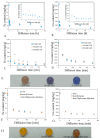Radiation-Sensitive Nano-, Micro-, and Macro-Gels and Polymer Capsules for Use in Radiotherapy Dosimetry
- PMID: 40724857
- PMCID: PMC12294773
- DOI: 10.3390/ijms26146603
Radiation-Sensitive Nano-, Micro-, and Macro-Gels and Polymer Capsules for Use in Radiotherapy Dosimetry
Abstract
This work introduces an original approach to the manufacturing of ionizing radiation-sensitive systems for radiotherapy applications-dosimetry. They are based on the Fricke dosimetric solution and the formation of macro-gels and capsules, and nano- and micro-gels. The reaction of ionic polymers, such as sodium alginate, with Fe and Ca metal ions is employed. Critical polymer concentration (c*) is taken as the criterion. Reaction of ionic polymers with metal ions leads to products related to c*. Well below c*, nano- and micro-gels may form. Above c*, macro-gels and capsules can be prepared. Nano- and micro-gels containing Fe in the composition can be used for infusion of a physical gel matrix to prepare 2D or 3D dosimeters. In turn, macro-gels can be formed with Fe ions crosslinking polymer chains to obtain radiation-sensitive hydrogels, so-called from wall-to-wall, serving as 3D dosimeters. The encapsulation process can lead to capsules with Fe ions serving as 1D dosimeters. This work presents the concept of manufacturing various gel structures, their main features and manufacturing challenges. It proposes new directions of research towards novel dosimeters.
Keywords: 3D dosimeter; Fricke gel dosimeter; ionizing radiation; macro-gels; micro-gels; radiotherapy dosimeter.
Conflict of interest statement
The authors declare no conflicts of interest.
Figures
















Similar articles
-
A systematic review of the precision and accuracy of dose measurements in photon radiotherapy using polymer and Fricke MRI gel dosimetry.Phys Med Biol. 2002 Oct 21;47(20):R107-21. doi: 10.1088/0031-9155/47/20/201. Phys Med Biol. 2002. PMID: 12433119
-
Management of urinary stones by experts in stone disease (ESD 2025).Arch Ital Urol Androl. 2025 Jun 30;97(2):14085. doi: 10.4081/aiua.2025.14085. Epub 2025 Jun 30. Arch Ital Urol Androl. 2025. PMID: 40583613 Review.
-
Short-Term Memory Impairment.2024 Jun 8. In: StatPearls [Internet]. Treasure Island (FL): StatPearls Publishing; 2025 Jan–. 2024 Jun 8. In: StatPearls [Internet]. Treasure Island (FL): StatPearls Publishing; 2025 Jan–. PMID: 31424720 Free Books & Documents.
-
Sexual Harassment and Prevention Training.2024 Mar 29. In: StatPearls [Internet]. Treasure Island (FL): StatPearls Publishing; 2025 Jan–. 2024 Mar 29. In: StatPearls [Internet]. Treasure Island (FL): StatPearls Publishing; 2025 Jan–. PMID: 36508513 Free Books & Documents.
-
Feasibility of a normoxic N-vinylpyrrolidone-based polymer gel (VIPET) dosimeter for three-dimensional proton beam measurements.J Appl Clin Med Phys. 2025 Jul;26(7):e70165. doi: 10.1002/acm2.70165. J Appl Clin Med Phys. 2025. PMID: 40657672 Free PMC article.
References
-
- Slotman B.J., Solberg T.D., Verellen D., editors. Extracranial Stereotactic Radiotherapy and Radiosurgery. Taylor & Francis; Abingdon-on-Thames, UK: 2005.
-
- Trifiletti D.M., Chao S.T., Sahgal A., Sheehan J.P., editors. Stereotactic Radiosurgery and Stereotactic Body Radiation Therapy. A Comprehensive Guide. Springer Nature; Basel, Switzerland: 2019.
-
- Swiss Society of Radiobiology and Medical Physics . Quality Control of Medical Electron Accelerators. Recommendations Number 11. Swiss Society of Radiobiology and Medical Physics; Geneva, Switzerland: 2015.
-
- Fricke H., Morse S. The chemical action of Roentgen rays on dilute ferrosulphate solutions as a measure of dose. Am. J. Roent. Radium Ther. Nucl. Med. 1927;18:430–432.
MeSH terms
Substances
LinkOut - more resources
Full Text Sources
Medical

